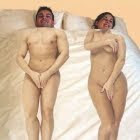As i like learning stuff i of course went and searched the net to find out this is what i found out
This is the simple reason why you get tired
When you eat, your brain diverts energy towards digestion, sending a bunch of red blood cells over to help break down the food and carry the nutrients all over your body!
Because so many blood cells are helping out the intestines, the rest of your body takes this time to slow down and relax.
As a result, you might feel tired, since your brain doesn't have as many blood cells to help it out at the moment — more energy used for digesting food means less energy can be used for running around!
Now for the more technical version
1. Enzymes help break down food consumed to make it into smaller units so it can be absorbed by the body. Aside from this they act as catalyst to make something happen.
There are three types of enzymes that are needed by the body to digest food.
- First are digestive enzymes that are secreted by the salivary glands, stomach, pancreas, endocrine cells and small intestine.
- Second, enzymes found in raw foods are consumed.
- And third, the metabolic enzyme that functions as catalyst to produce energy, remove dirt and toxins.
While eating, these body enzymes have to work very hard to digest all the food we take int. Because it is considered hard work, our body feels tired and exhausted so we feel drowsy and tired
2. There is a combining or mixing of inappropriate food.
Many people do not know how to combine food. Some foods require special enzymes to be digested like proteins require protease, carbohydrates require amylase, and fats require lipase. If a person eats protein and lots of carbohydrates at a time it could lead to conflict within the digestive enzymes.
It would be best to combine protein with non-starch vegetables, combining carbohydrates with vegetables, grains, etc.
3. The influence of one neuron can affect too. A person can get drowsy after eating orexin neurons. Neurons are located in hypothalamus, a part of the brain that regulates many processes and almost all hormones.
So now you know all this, will it change how you eat so you don't get tired?









